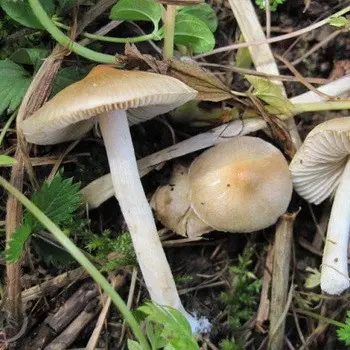 Fiber is found almost everywhere and often gets into human food randomly. Fiber is a poisonous fungus that causes severe poisoning. The person needs medical attention. This page provides a description of the poisonous fibrous fungus and its varieties. You can learn about the symptoms of poisoning and see the photo.
Fiber is found almost everywhere and often gets into human food randomly. Fiber is a poisonous fungus that causes severe poisoning. The person needs medical attention. This page provides a description of the poisonous fibrous fungus and its varieties. You can learn about the symptoms of poisoning and see the photo.
Family: Cobwebs (Cortinariaceae).
Synonyms: fiber torn (torn), fiber sharp.
The description of the fiber can be read below in great detail. Cap 2-8 cm in diameter, cone-shaped, then bell-shaped with a sharp tubercle, silky fibrous, with translucent flesh, with longitudinal radial cracks, often with a wavy torn edge, whitish, ocher, dirty yellow, yellow ocher. The flesh is white or yellowish, with a somewhat unpleasant odor and taste. The plates are wide, frequent, at first light, whitish, grayish or yellowish, later grayish-brown with an olive tint and a light pubescent or serrated edge. Leg 4-7 X 0,4-0,8 cm, central, expanding towards the base, light at the top with powdery coating, reddish-brown below.
It is distributed throughout the temperate zone of Our Country in deciduous and coniferous forests, on the ground, among grass, along roads, and is quite common. Fruiting from late June to early October.
The fiber is sharp, torn and torn
It differs from other closely related fibers in its relatively large size and characteristic fissured cap. There is also an acute fiber, which is similar to the described species. The torn fiber is less common; it also belongs to this species. Ragged fiber is the least common, it is also very poisonous.
The following are fiber mushrooms in the photo, which show a variety of species:
Pharmacological and medical properties
[ »»]
A poisonous mushroom containing muscarine in a significantly higher concentration than the red fly agaric. Heat treatment during cooking does not destroy toxic molecules. Muscarine and its derivatives are absorbed in the gastrointestinal tract. Absorbed muscarine is rapidly distributed throughout the body, symptoms may appear within 30 minutes after eating. After reaching the maximum level, the signs of poisoning begin to decrease. All signs of muscarine poisoning disappear within 24 hours.
Symptoms of fiber poisoning:
Cardiovascular: sinus bradycardia, hypotension.
Respiratory: secretion of bronchial mucus and bronchospasm leading to hypoxemia.
Gastrointestinal: excessive salivation is an important sign of intoxication, nausea, vomiting, increased peristalsis with diarrhea and abdominal pain. Bitter taste in the mouth.
Dermatological: excessive sweating, it happens that a person’s clothes and bed are completely wet.
Eyes, ears, nose, throat, local effects: miosis, blurred vision, excessive lacrimation, nasal congestion and runny nose.
Traditional and folk medicine. In folk medicine, it is used to treat eczema. Collect fresh fruiting bodies for the preparation of ointments and compresses based on vodka tincture.
The mushroom is poisonous, food use is excluded.









